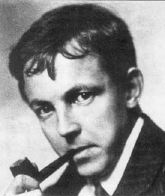

G. H. Hardy attended Cranleigh school up to the age of 12 with great success, but he did not appear to have the passion for mathematics that many mathematicians experience when young. He won a scholarship to Winchester College in 1889, entering the College the following year. Like all public schools it was a rough place for a frail, shy boy like Hardy. While at Winchester, Hardy won an open scholarship to Trinity College Cambridge, which he entered in 1896. He was turned on to mathematics by A. E. H. Love. Hardy was elected a fellow of Trinity in 1900 then, and the next year he was awarded a Smith's prize.
Hardy was a very private man. He never did marry, and he
was always known as Hardy except to one or two close friends who called him Harold.
In the next 10 years, he wrote many papers on the convergence of series and integrals and allied topics. Although this work established his reputation as an analyst, his greatest service to mathematics in this early period was A course of pure mathematics, published in 1908. This work was the first rigorous English exposition of number, function, limit, and so on, adapted to the undergraduate, and it transformed university teaching.
A major change in Hardy's work came about in 1911 when he began his collaboration with Littlewood, which was to last 35 years. His long collaboration with Littlewood produced mathematics of the highest quality. It was a collaboration in which Hardy acknowledged Littlewood's greater technical mathematical skills, but at the same time Hardy brought great talents of mathematical insight and a great ability to write their work up in papers with great clarity.
In early 1913, he received Ramanujan's first letter from India, which was to start his second major collaboration. Hardy instantly spotted Ramanujan's genius from a manuscript sent to him by Ramanujan. Hardy brought Ramanujan to Cambridge and they wrote 5 remarkable papers together.
During World War I, Hardy was unhappy at Cambridge, and he took the opportunity to leave in 1919 when he was appointed as Savilian professor of geometry at Oxford. These are the years when he produced his best mathematics in the collaboration with Littlewood. Despite having been unhappy at Cambridge, Hardy returned to the Sadleirian chair there in 1931 when Hobson retired, because he still considered Cambridge the center of English mathematics, and the Sadleirian chair was the foremost mathematics chair in England.
Hardy's interests covered many topics of pure mathematics - Diophantine analysis, summation of divergent series, Fourier series, the Riemann zeta function, and the distribution of primes.
He wrote joint papers with Titchmarsh, Ingham, Landau, Pólya, Wright, Rogosinski and Riesz.
Hardy was a pure mathematician who hoped his mathematics could never be applied. However in 1908, near the beginning of his career, he gave a law describing how the proportions of dominant and recessive genetic traits would be propagated in a large population. Hardy considered it unimportant but it has proved of major importance in blood group distribution.
Hardy was known for his eccentricities. He could not endure having his photograph taken and only 5 snapshots are known to exist. He also hated mirrors and his first action on entering any hotel room was to cover any mirror with a towel. He always played an amusing game of trying to fool God, which is also rather strange since he claimed all his life not be believe in God. For example, during a trip to Denmark he sent back a postcard claiming that he had proved
the Riemann hypothesis. He reasoned that God would not allow the boat to sink on the return journey and give him the same fame that Fermat had achieved with his "last theorem".
Hardy's book A mathematicians apology was written in 1940. It is one of the most vivid descriptions of how a mathematician thinks and the pleasure of mathematics.
Hardy received many honours for his work. He was elected a Fellow of the Royal Society in 1910. He received the Royal Medal of the Society in 1920, the
Sylvester Medal of the Society in 1940, and the Copley Medal of the Royal Society in 1947.
He was president of the London Mathematical Society from 1926 to 1928, and again from 1939 to 1941. He received the De Morgan Medal of the Society in 1929.